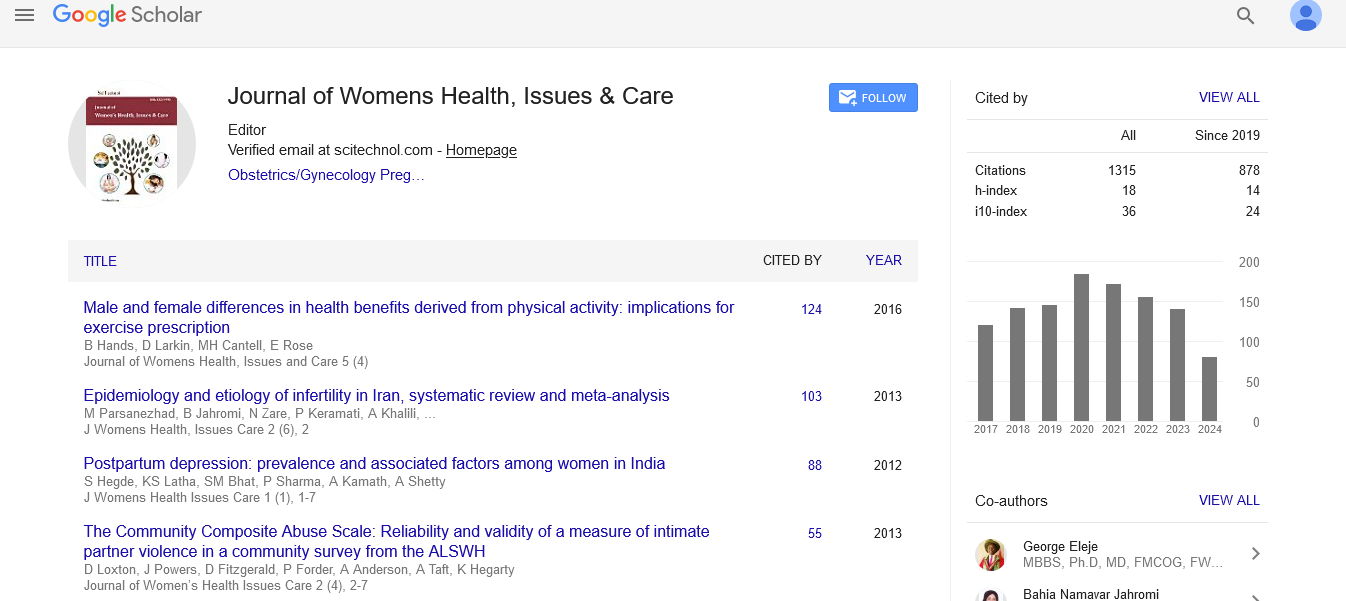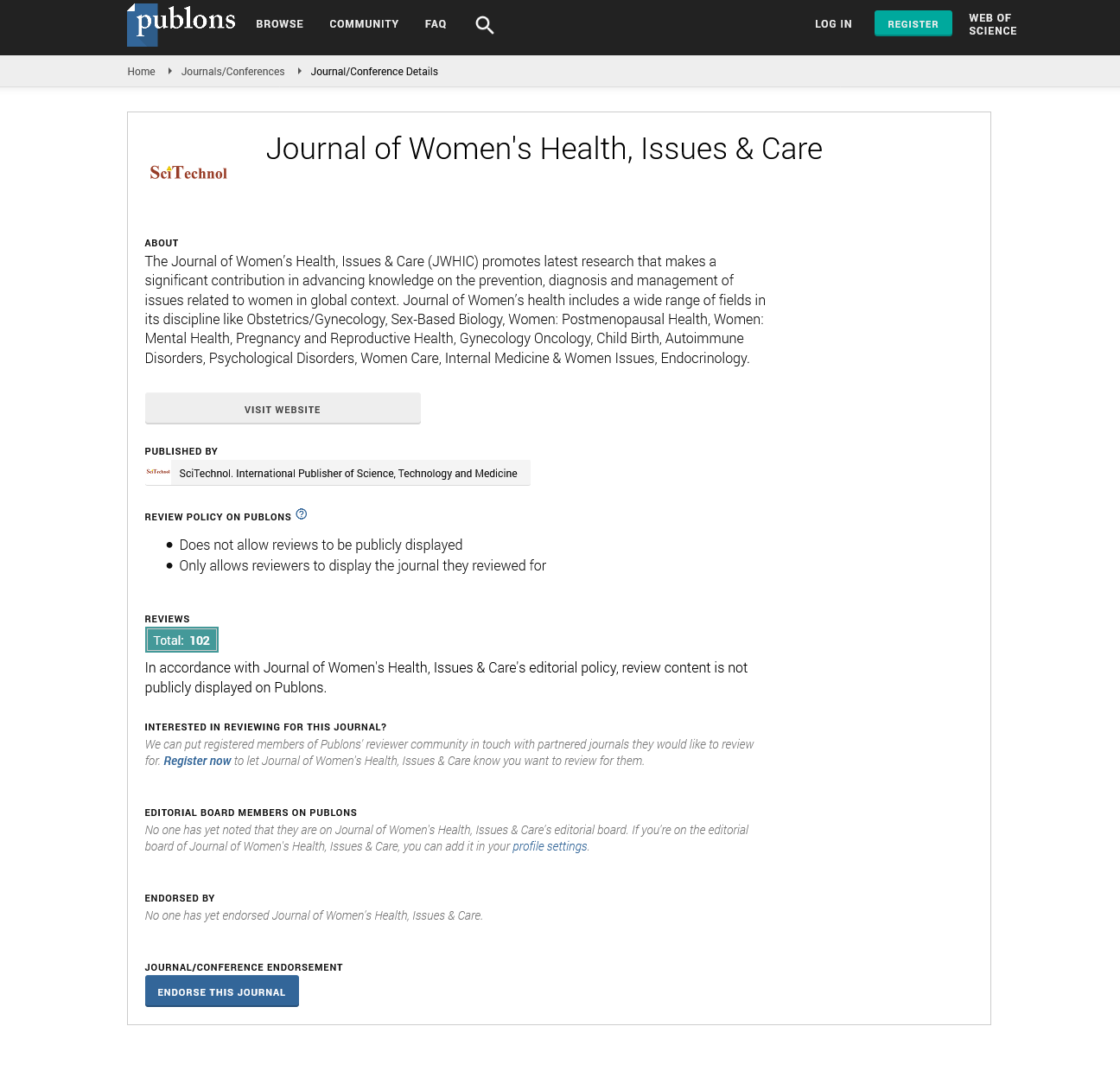Commentary, J Womens Health Vol: 13 Issue: 4
Psychosocial Factors Influencing Pain Perception in Endometriosis: Implications for Treatment
Mason Holson*
1Department of Gynecology and Obstetrics, Bern University, Bern, Switzerland
*Corresponding Author: Mason Holson,
Department of Gynecology and
Obstetrics, Bern University, Bern, Switzerland
E-mail: mason_holson@gmail.com
Received date: 23 July, 2024, Manuscript No. JWHIC-24-150184;
Editor assigned date: 25 July, 2024, PreQC No. JWHIC-24-150184 (PQ);
Reviewed date: 08 August, 2024, QC No. JWHIC-24-150184;
Revised date: 16 August, 2024, Manuscript No. JWHIC-24-150184 (R);
Published date: 23 August, 2024 DOI: 10.4172/2325-9795.1000508.
Citation: Holson M (2024) Psychosocial Factors Influencing Pain Perception in Endometriosis: Implications for Treatment. J Womens Health 13:4.
Description
Endometriosis is a complex and often misunderstood condition that affects millions of women worldwide. It occurs when tissue similar to the lining of the uterus (the endometrium) grows outside the uterus, leading to a range of symptoms and potential complications. Understanding the symptoms and treatment options is important for effective management and improving quality of life. Endometriosis is a chronic condition that can impact various aspects of a woman’s life, including physical health, emotional well-being and fertility. The misplaced endometrial-like tissue can be found on the ovaries, fallopian tubes, outer surface of the uterus and other organs within the pelvis. In some cases, it can even spread beyond the pelvic organs. Endometriosis affects an estimated 1 in 10 women of reproductive age, though many may go undiagnosed for years. Symptoms can vary widely, leading to a delay in diagnosis and treatment. The symptoms of endometriosis can vary significantly among individuals, and some may experience severe symptoms while others have mild discomfort. Often the most prominent symptom, pelvic pain typically correlates with the menstrual cycle. However, some women may experience chronic pelvic pain that is not linked to their periods. Women with endometriosis may experience heavy periods (menorrhagia) or bleeding between periods (intermenstrual bleeding). Pain during or after sex is common in those with endometriosis, often due to the presence of endometrial tissue in areas around the reproductive organs. These symptoms may occur especially during menstrual periods. Endometriosis is one of the leading causes of infertility in women. Some women discover they have the condition while seeking treatment for infertility. Fatigue, diarrhea, constipation, bloating and nausea can also occur, particularly during menstruation.
Diagnosis of Endometriosis
Diagnosing endometriosis can be challenging due to the overlap of symptoms with other conditions. Discussing symptoms, menstrual cycle patterns and any family history of endometriosis. A pelvic exam may help identify cysts or scars behind the uterus. Ultrasound or MRI can provide visual insight into the pelvic organs, although they cannot definitively diagnose endometriosis. This minimally invasive surgical procedure allows for direct visualization of endometrial-like tissue and can confirm a diagnosis. Treatment for endometriosis aims to alleviate symptoms and improve quality of life. Options vary depending on the severity of the condition, the symptoms experienced and individual preferences. Nonsteroidal Anti-Inflammatory Drugs (NSAIDs) like ibuprofen or naproxen can help manage mild to moderate pain. For more severe pain, doctors may prescribe stronger pain relievers or other medications. Hormonal treatments can help reduce or eliminate menstruation, thereby lessening the symptoms of endometriosis.
Combined hormonal contraceptives can help regulate periods and reduce pain. Progestin-only medications can stop menstruation and in some cases, shrink endometrial tissue. These medications induce a temporary menopause-like state to reduce estrogen levels, helping to decrease endometriosis lesions. Surgery may be considered for women with severe symptoms or those who wish to become pregnant. This procedure allows for the removal of endometrial tissue, adhesions and cysts. It can relieve symptoms and improve fertility. In severe cases, removing the uterus (and possibly the ovaries) may be recommended, particularly for women who do not plan to conceive in the future. In addition to medical treatments, many women find relief through lifestyle changes and complementary therapies.
Conclusion
Endometriosis is a complex condition that requires a multi-faceted approach for effective management. Understanding the symptoms and available treatment options is important for those affected. A balanced diet rich in anti-inflammatory foods may help manage symptoms. Regular physical activity can improve overall well-being and reduce pain. Acupuncture, chiropractic care and yoga may provide additional relief from symptoms. Early diagnosis and personalized treatment can significantly improve quality of life, allowing women to lead healthier, more fulfilling lives. With ongoing research and increased awareness, we can hope for better management strategies and support for those living with this condition.
 Spanish
Spanish  Chinese
Chinese  Russian
Russian  German
German  French
French  Japanese
Japanese  Portuguese
Portuguese  Hindi
Hindi 



